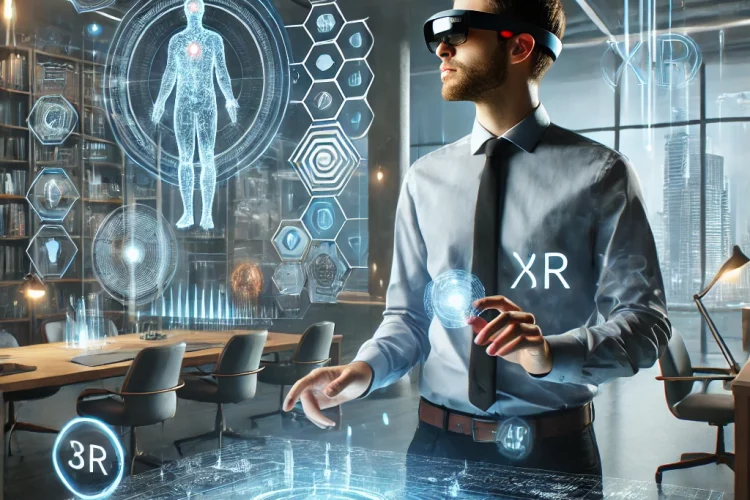
- By Retford TECH
- In Tech News
Exploring the Future of Immersive and Extended Reality (XR) in 2024
Exploring the Future of Immersive and Extended Reality (XR) in 2024
Extended Reality (XR), which encompasses Virtual Reality (VR), Augmented Reality (AR), and Mixed Reality (MR), is set to redefine how we interact with the digital and physical worlds in 2024. XR’s influence is expanding rapidly beyond gaming and entertainment, reaching sectors like healthcare, education, training, and business. With advancements in 5G, AI, and digital twins, XR is becoming more accessible and powerful, creating transformative experiences across industries.
Key Trends in XR for 2024
- Mainstream Adoption and Accessibility
In 2024, XR will shift from being a niche technology to mainstream adoption. This is driven by more affordable and accessible XR devices, such as the Meta Quest 3 and Apple Vision Pro, which integrate high-resolution displays and advanced tracking technologies. These devices allow users to blend virtual and physical environments seamlessly, offering immersive experiences for gaming, education, and professional training. - Immersive Learning and Training
XR is revolutionizing education and training by offering immersive simulations that provide hands-on learning in risk-free environments. Educational institutions are adopting XR for virtual experiments and historical recreations, while healthcare professionals use XR for realistic medical training. The use of XR in business training, particularly for complex tasks, allows employees to learn and refine skills in virtual environments, reducing the need for costly in-person sessions. - Multi-Sensory Experiences
XR experiences are evolving beyond visual immersion to include other senses. The integration of haptic feedback, spatial audio, and even olfactory elements will enhance how users interact with virtual content. These developments promise to blur the lines between the real and virtual worlds, providing more engaging and realistic experiences across sectors such as gaming, healthcare, and entertainment. - Generative AI and Personalization
Generative AI is set to play a critical role in shaping the future of XR. In 2024, AI-driven environments will adapt to users in real-time, creating personalized virtual worlds. AI-generated content will enhance interaction within XR environments, making them more dynamic and tailored to individual preferences, from personalized characters to evolving landscapes. - XR in Social and Collaborative Spaces
As XR platforms evolve, they are becoming essential social hubs. Virtual meetings, concerts, and collaborative workspaces will become more commonplace, allowing users to interact in digital environments as if they were physically present. XR will bridge geographical gaps and foster meaningful interactions in both personal and professional settings. - Advances in Spatial Computing and 3D Mapping
XR applications are leveraging spatial computing and 3D mapping to provide more accurate and responsive virtual environments. These technologies are used in everything from indoor navigation to augmented shopping experiences, enabling more intuitive interactions with digital content.
Industry-Specific Applications of XR
- Healthcare: XR is enabling more effective medical training through virtual surgeries and simulations, allowing professionals to practice complex procedures without the risks associated with real-world mistakes. It is also being explored for therapeutic applications, offering immersive environments to help with mental health treatments like anxiety management.
- Manufacturing and Engineering: With digital twins, XR is transforming industries by allowing workers to simulate and interact with virtual replicas of physical assets. This reduces testing and prototyping costs and enables real-time collaboration between geographically dispersed teams.
- Retail and Marketing: XR is becoming a powerful tool for immersive marketing. Augmented Reality (AR) allows brands to create interactive experiences where customers can visualize products in their own space, enhancing engagement and making shopping more dynamic and personalized.
The Future of XR: A New Reality
As we move into 2024, XR is set to become an integral part of everyday life, thanks to improvements in hardware, such as smartglasses and AR wearables, and advancements in network infrastructure like 5G. These technologies will allow for more seamless, real-time XR experiences that can be integrated into daily routines, from immersive work environments to interactive entertainment and education.
With its growing potential, XR is on the verge of transforming how we experience and interact with both digital and physical worlds, ushering in a new era of immersion and interactivity.





